The 5 Best Self-Service Analytics Tools
The way businesses analyze data is evolving, with self-service analytics tools becoming a key trend. These tools allow employees without technical expertise to independently explore data, generate insights and make informed decisions.
In this guide, we’ll explore what self-service analytics is, how it works, and what features to look for in a tool. Plus, we’ll highlight five popular tools for 2025 and give you practical tips on finding the best one for your team.
So what exactly is Self-Service Analytics?
Self-service analytics lets users ask questions and explore insights based on their company’s data. Essentially, it enables employees, even those without data expertise- to access and analyze data independently. Instead of relying on data or engineering teams for every report, users can directly pull the information they need, fostering a data-driven culture and helping the company make faster, more informed decisions.
A common challenge in many organizations is the disconnect between business teams and technical teams. Self-service analytics tools bridge that gap by putting data insights directly in the hands of business users.
How does Self-Service Analytics work?
Self-service analytics tools are designed with accessibility in mind. They often include intuitive interfaces, drag and drop dashboards and AI-powered insights, making it easier for non-technical users to interact with data. Here’s a closer look at some common features:
- Real-time access to data: Users can easily access the latest data.
- Templates and dashboards: Ready to use reports – minimize setup time.
- AI-powered insights: Suggestions, trend detection and forecasting tools help users uncover deeper insights.
- Collaboration tools: Integrations with apps like Teams and Slack enable seamless sharing and communication.
- Natural language querying: Let users ask questions and get answers in everyday business language.
Benefits of Self-Service Analytics
Self-service analytics tools offer many benefits that help improve decision-making and productivity across the organization. Here’s why they’re worth considering:
- Increased efficiency: Reduces the time spent waiting for reports from technical teams.
- Data democratization: Puts data in the hands of those who need it, from marketing to operations.
- Improved decision-making: Easy accessible answers that encourage faster and more informed data driven decisions.
- Deeper insights: Enabling users to dive deeper into data and uncover hidden trends by encouraging users to ask more curious questions.
- Scalability: Self service platforms can grow the organization, supporting both small teams and enterprise operations.
What to look for in a Self-Service Analytics Tool?
Choosing the right tool means ensuring it meets both your business needs and your users’ requirements. Here are a few essential aspects to consider:
- Contextual intelligence: The tool should understand your key metrics, industry needs, and business goals.
- Easy of use: Look for platforms that are intuitive enough for non-specialists to use effectively.
- Collaborative integrations: Integration with apps like Slack or Teams keeps insights accessible to your team.
- Advanced visualizations: Effective visualization is crucial, not just for pretty charts but for meaningful insights that guide decisions.
- AI-powered recommendations: The best platforms help users identify patterns and suggest next steps.
- Scalability: Make sure the tool can scale as your organization grows and as your data needs become more complex.
The 5 Best Tools for Self-Service Analytics 2025?
1. Magnowlia
Magnowlia is an innovative, AI-powered self-service analytics platform built to simplify complex data analysis for businesses of all sizes. With its intuitive interface and seamless integrations. Magnowlia enables non-technical users to generate valuable insights and easily share them across teams. Whether your organization needs real-time data visualizations, advanced AI-driven predictions, or in-depth data exploration, Magnowlia empowers employees to make faster, more informed decisions. Designed to democratize data, Magnowlia makes analytics accessible to everyone -not just technical teams, ensuring a truly data-driven culture across the organization.
Pros:
- AI- driven insights
- Conversational analytics
- Seamless integration with Slack and Teams.
Cons:
- No Dashboards
- Conversational rather than point and click
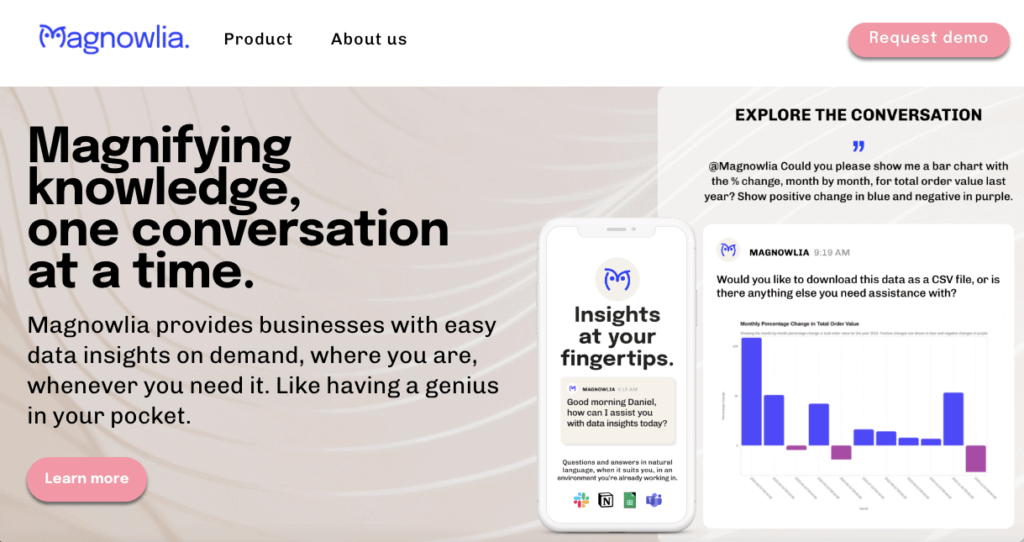
2. Thoughtspot
ThoughtSpot is a powerful search-based analytics platform that allows users to query data using natural language and receive instant visualizations. Designed to simplify data access, ThoughtSpot makes it easy for teams to get quick ad-hoc insights without technical complexity. The platform engine offers intelligent suggestions and automatically highlights trends and key insights, enabling deeper analysis and data discovery. ThoughtSpot is ideal for organizations aiming to democratize analytics since it empowers users across all levels to independently explore data and make informed decisions in real-time.
Pros:
- Natural language querying
- Embedded analytics for external tools
- AI-powered anomaly detection
Cons:
- High cost
- Complex implementation
- Limited customization in visualization
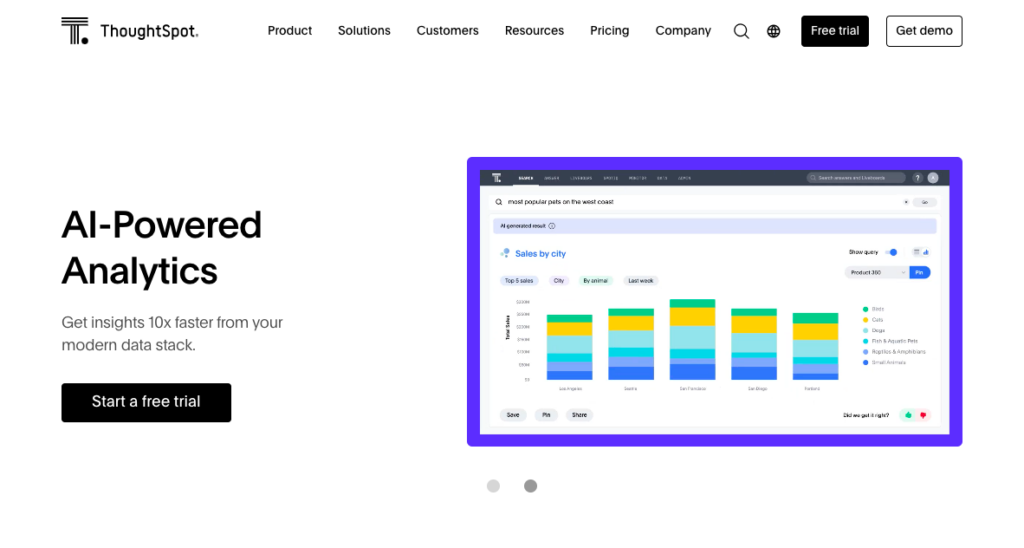
3. Metabase
Metabase is an open-source analytics platform that combines flexibility with ease of use, making it a versatile choice for teams looking to tailor their data experience. It’s customizable dashboards and query options allow businesses to adapt the platform to their specific needs, while its user-friendly interface empowers non-technical users to explore data independently. For more advanced analysis, Metabase provides full SQL support, enabling technical users to perform in-depth querying and analysis. Especially popular with startups and development teams, Metabase is ideal for organizations seeking both simplicity and advanced capabilities without sacrificing control or flexibility.
Pros:
- SQL support for advanced users
- Open-source flexibility for customization
- Easy sharing and embedding of dashboards
Cons:
- Scalability and performance constraints
- Limited advanced analytics features
- Basic customization in visualizations
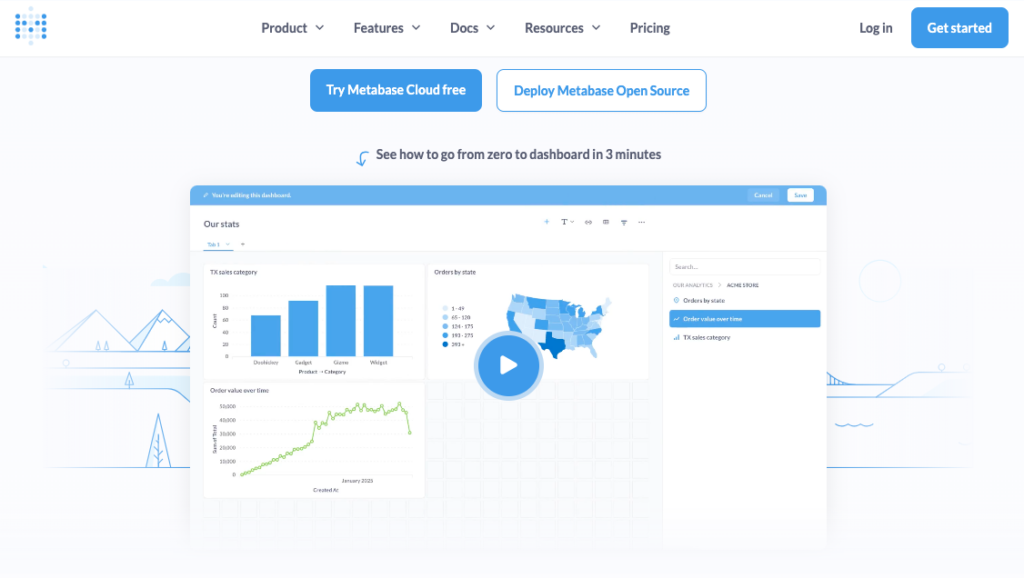
4. Snowflakes Cortex analyst
Designed for enterprises, Cortex Analyst leverages Snowflake’s data cloud to deliver powerful analytics across large and complex datasets. It offers built-in AI tools to help organizations extract meaningful insights from their data, delivering forecasting, recommendations and detailed visualizations that support smarter decisions. Cortex Analyst is perfect for companies that need scalable, high-performance analytics to support complex business needs.
Pros:
- Cloud-based architecture for scalability
- AI-driven forecasting and recommendations
- Advanced integrations with data lakes and warehouses
Cons:
- Limited capabilities
- Commitment to Snowflake ecosystem
- Limited advanced analytics features
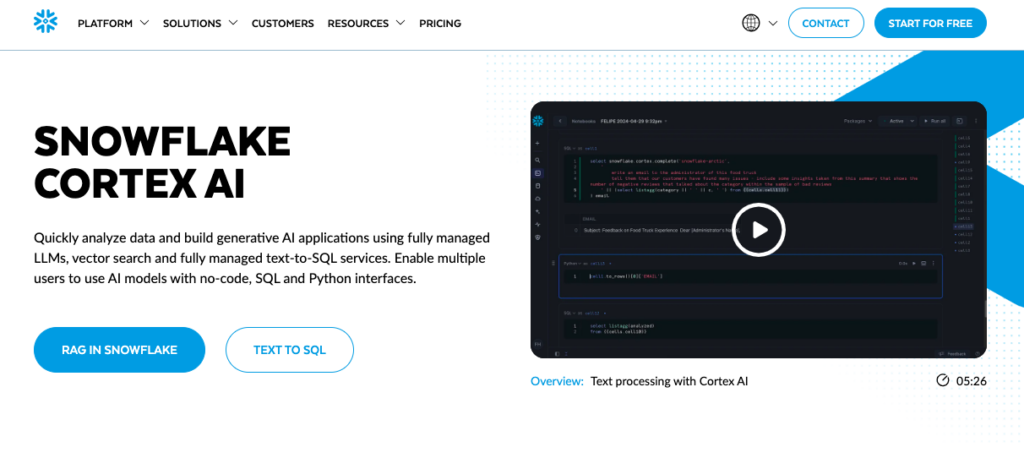
5. Steep
Steep is a straightforward data visualization platform focused on simplicity and accessibility. With its intuitive drag-and-drop functionality, Steep allows users to create interactive dashboards effortlessly, making data analysis accessible for non-technical teams in need of quick, actionable insights. This user-friendly design and focus on rapid insights make Steep an excellent choice for businesses that prioritize fast, straightforward access to visual data representations without added complexity.
Pros:
- Simple drag-and-drop dashboard creation
- Customizable visual elements
- Real-time alerts for key metrics
Cons:
- Limited advanced analytics
- Integration constraints
- Potential performance issues with large datasets
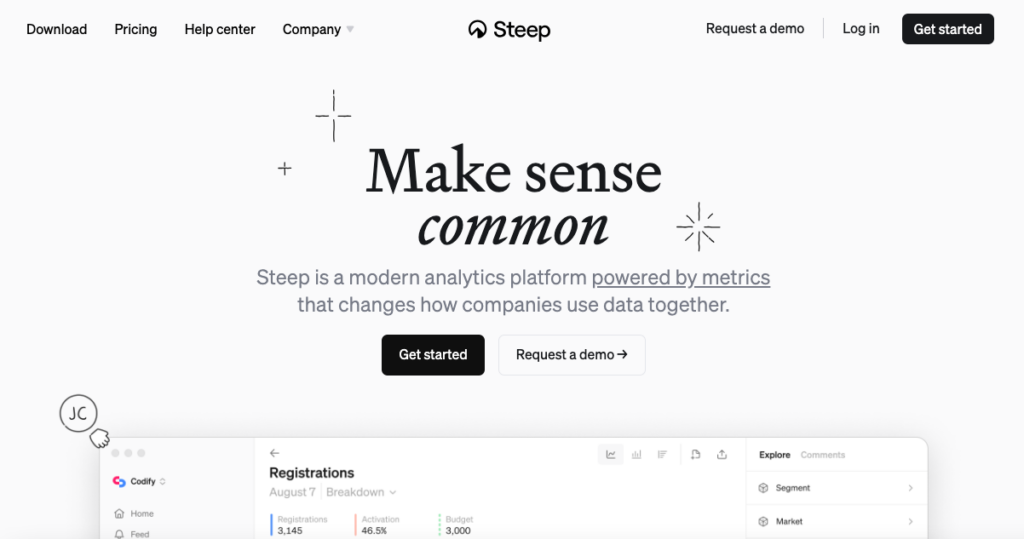
Questions to ask when choosing a Self-Service Analytics tool.
Choosing the right self-service analytics tool is a crucial decision for any business aiming to make data insights accessible and actionable across the organization. Here are essential questions to consider to ensure you select a tool that truly democratizes data and meets your company’s needs:
- Is the tool truly Self- Service?
Self-service analytics should empower all team members, regardless of technical expertise, to independently access insights and build reports. But how easy is it really? Can anyone, even those without a technical background, comfortably use the tool to explore data and create dashboards? This is a key question, since many tools allow users to view pre-built dashboards, but not all enable them to easily generate new ones, making it essential to evaluate usability for non-technical users.
- How flexible is the tool in answering different types of questions?
A flexible analytics tool should let users ask all kinds of questions freely, without limiting the data types or sources they can explore. Check if the tool restricts you to certain preset data points or if it allows for ad-hoc analysis that can address unique, changing business questions. Tools with natural language querying add even more flexibility, letting users ask questions in everyday language and follow up easily, helping them dive deeper into the data.
- Does the tool offer a guided experience for non-data experts?
Ensure the tool offers guidance or recommendations to help users who may be unfamiliar with data, making it easy for them to explore and understand the data they’re working with.
Conclusion.
Selecting the right self-service analytics tool is crucial for organizations looking to cultivate a data-driven culture. By asking the right questions about usability, flexibility and support for non-data experts, businesses can find a solution that truly fits their needs. An effective analytics tool should empower users to ask a wide range of questions, encourage deeper exploration through follow-up inquiries, and offer an intuitive interface that makes data engagement accessible to everyone, regardless of their technical background.
Self-service analytics is more than just a tool; it’s an investment in your team’s ability to work independently with data and drive positive outcomes for your business.
The way businesses analyze data is evolving, with self-service analytics tools becoming a key trend. These tools allow employees without technical expertise to independently explore data, generate insights and make informed decisions.
In this guide, we’ll explore what self-service analytics is, how it works, and what features to look for in a tool. Plus, we’ll highlight five popular tools for 2025 and give you practical tips on finding the best one for your team.
So what exactly is Self-Service Analytics?
Self-service analytics lets users ask questions and explore insights based on their company’s data. Essentially, it enables employees, even those without data expertise- to access and analyze data independently. Instead of relying on data or engineering teams for every report, users can directly pull the information they need, fostering a data-driven culture and helping the company make faster, more informed decisions.
A common challenge in many organizations is the disconnect between business teams and technical teams. Self-service analytics tools bridge that gap by putting data insights directly in the hands of business users.
How does Self- Service Analytics work?
Self-service analytics tools are designed with accessibility in mind. They often include intuitive interfaces, drag and drop dashboards and AI-powered insights, making it easier for non-technical users to interact with data. Here’s a closer look at some common features:
- Real-time access to data: Users can easily access the latest data.
- Templates and dashboards: Ready to use reports – minimize setup time.
- AI-powered insights: Suggestions, trend detection and forecasting tools help users uncover deeper insights.
- Collaboration tools: Integrations with apps like Teams and Slack enable seamless sharing and communication.
- Natural language querying: Let users ask questions and get answers in everyday business language.
Benefits of Self-Service Analytics
Self-service analytics tools offer many benefits that help improve decision-making and productivity across the organization. Here’s why they’re worth considering:
- Increased efficiency: Reduces the time spent waiting for reports from technical teams.
- Data democratization: Puts data in the hands of those who need it, from marketing to operations.
- Improved decision-making: Easy accessible answers that encourage faster and more informed data driven decisions.
- Deeper insights: Enabling users to dive deeper into data and uncover hidden trends by encouraging users to ask more curious questions.
- Scalability: Self service platforms can grow the organization, supporting both small teams and enterprise operations.
What to look for in a Self-Service Analytics tool?
Choosing the right tool means ensuring it meets both your business needs and your users’ requirements. Here are a few essential aspects to consider:
- Contextual intelligence: The tool should understand your key metrics, industry needs, and business goals.
- Easy of use: Look for platforms that are intuitive enough for non-specialists to use effectively.
- Collaborative integrations: Integration with apps like Slack or Teams keeps insights accessible to your team.
- Advanced visualizations: Effective visualization is crucial, not just for pretty charts but for meaningful insights that guide decisions.
- AI-powered recommendations: The best platforms help users identify patterns and suggest next steps.
- Scalability: Make sure the tool can scale as your organization grows and as your data needs become more complex.
The 5 Best Tools for Self-Service Analytics 2025?
1. Magnowlia
Magnowlia is an innovative, AI-powered self-service analytics platform built to simplify complex data analysis for businesses of all sizes. With its intuitive interface and seamless integrations. Magnowlia enables non-technical users to generate valuable insights and easily share them across teams. Whether your organization needs real-time data visualizations, advanced AI-driven predictions, or in-depth data exploration, Magnowlia empowers employees to make faster, more informed decisions. Designed to democratize data, Magnowlia makes analytics accessible to everyone -not just technical teams, ensuring a truly data-driven culture across the organization.
Pros:
- AI- driven insights
- Conversational analytics
- Seamless integration with Slack and Teams.
Cons:
- No Dashboards
- Conversational rather than point and click

2. Thoughtspot
ThoughtSpot is a powerful search-based analytics platform that allows users to query data using natural language and receive instant visualizations. Designed to simplify data access, ThoughtSpot makes it easy for teams to get quick ad-hoc insights without technical complexity. The platform engine offers intelligent suggestions and automatically highlights trends and key insights, enabling deeper analysis and data discovery. ThoughtSpot is ideal for organizations aiming to democratize analytics since it empowers users across all levels to independently explore data and make informed decisions in real-time.
Pros:
- Natural language querying
- Embedded analytics for external tools
- AI-powered anomaly detection
Cons:
- High cost
- Complex implementation
- Limited customization in visualization
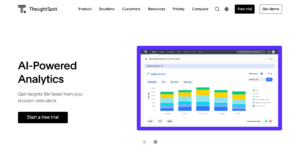
3. Metabase
Metabase is an open-source analytics platform that combines flexibility with ease of use, making it a versatile choice for teams looking to tailor their data experience. It’s customizable dashboards and query options allow businesses to adapt the platform to their specific needs, while its user-friendly interface empowers non-technical users to explore data independently. For more advanced analysis, Metabase provides full SQL support, enabling technical users to perform in-depth querying and analysis. Especially popular with startups and development teams, Metabase is ideal for organizations seeking both simplicity and advanced capabilities without sacrificing control or flexibility.
Pros:
- SQL support for advanced users
- Open-source flexibility for customization
- Easy sharing and embedding of dashboards
Cons:
- Scalability and performance constraints
- Limited advanced analytics features
- Basic customization in visualizations

4. Snowflakes Cortex analyst
Designed for enterprises, Cortex Analyst leverages Snowflake’s data cloud to deliver powerful analytics across large and complex datasets. It offers built-in AI tools to help organizations extract meaningful insights from their data, delivering forecasting, recommendations and detailed visualizations that support smarter decisions. Cortex Analyst is perfect for companies that need scalable, high-performance analytics to support complex business needs.
Pros:
- Cloud-based architecture for scalability
- AI-driven forecasting and recommendations
- Advanced integrations with data lakes and warehouses
Cons:
- Limited capabilities
- Commitment to Snowflake ecosystem
- Limited advanced analytics features

5. Steep
Steep is a straightforward data visualization platform focused on simplicity and accessibility. With its intuitive drag-and-drop functionality, Steep allows users to create interactive dashboards effortlessly, making data analysis accessible for non-technical teams in need of quick, actionable insights. This user-friendly design and focus on rapid insights make Steep an excellent choice for businesses that prioritize fast, straightforward access to visual data representations without added complexity.
Pros:
- Simple drag-and-drop dashboard creation
- Customizable visual elements
- Real-time alerts for key metrics
Cons:
- Limited advanced analytics
- Integration constraints
- Potential performance issues with large datasets

Questions to ask when choosing a Self-Service Analytics tool.
Choosing the right self-service analytics tool is a crucial decision for any business aiming to make data insights accessible and actionable across the organization. Here are essential questions to consider to ensure you select a tool that truly democratizes data and meets your company’s needs:
- Is the tool truly Self- Service?
Self-service analytics should empower all team members, regardless of technical expertise, to independently access insights and build reports. But how easy is it really? Can anyone, even those without a technical background, comfortably use the tool to explore data and create dashboards? This is a key question, since many tools allow users to view pre-built dashboards, but not all enable them to easily generate new ones, making it essential to evaluate usability for non-technical users.
- How flexible is the tool in answering different types of questions?
A flexible analytics tool should let users ask all kinds of questions freely, without limiting the data types or sources they can explore. Check if the tool restricts you to certain preset data points or if it allows for ad-hoc analysis that can address unique, changing business questions. Tools with natural language querying add even more flexibility, letting users ask questions in everyday language and follow up easily, helping them dive deeper into the data.
- Does the tool offer a guided experience for non-data experts?
Ensure the tool offers guidance or recommendations to help users who may be unfamiliar with data, making it easy for them to explore and understand the data they’re working with.
Conclusion.
Selecting the right self-service analytics tool is crucial for organizations looking to cultivate a data-driven culture. By asking the right questions about usability, flexibility and support for non-data experts, businesses can find a solution that truly fits their needs. An effective analytics tool should empower users to ask a wide range of questions, encourage deeper exploration through follow-up inquiries, and offer an intuitive interface that makes data engagement accessible to everyone, regardless of their technical background.
Self-service analytics is more than just a tool; it’s an investment in your team’s ability to work independently with data and drive positive outcomes for your business.
SEEING IS BELIEVING.
Are you ready?
Tell us a bit about yourself, and we’ll show you how to boost your people, teams, and business. Let’s dive in.
